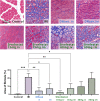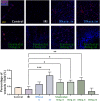DNase I and Sivelestat Ameliorate Experimental Hindlimb Ischemia-Reperfusion Injury by Eliminating Neutrophil Extracellular Traps
- PMID: 36852300
- PMCID: PMC9961174
- DOI: 10.2147/JIR.S396049
DNase I and Sivelestat Ameliorate Experimental Hindlimb Ischemia-Reperfusion Injury by Eliminating Neutrophil Extracellular Traps
Abstract
Purpose: Neutrophil extracellular traps (NETs) play an important role in ischemia-reperfusion injury (IRI) of the hindlimb. The aim of this study was to investigate the effect of recombinant DNase I and sivelestat in eliminating NETs and their effects on IRI limbs.
Patients and methods: An air pump was used to apply a pressure of 300 mmHg to the root of the right hindlimb of the rat for 2 h and then deflated to replicate the IRI model. The formation of NETs was determined by the detection of myeloperoxidase (MPO), neutrophil elastase (NE), and histone H3 in the skeletal muscles of the hindlimbs. Animals were administered 2.5 mg/kg bw/d DNase I, 15 or 60 mg/kg bw/d sivelestat by injection into the tail vein or intramuscularly into the ischemic area for 7d. Elimination of NETs, hindlimb perfusion, muscle fibrosis, angiogenesis and motor function were assessed.
Results: DNase I reduced NETs, attenuated muscle fibrosis, promoted angiogenesis in IRI area and improved limb motor function. Local administration of DNase I improved hindlimb perfusion more than intravenous administration. Sivelestat at a dose of 15 mg/kg bw/d increased perfusion, counteracted skeletal muscle fibrosis, promoted angiogenesis and enhanced motor function. However, sivelestat at a dosage of 60 mg/kg bw/d had an adverse effect on tissue repair, especially when injected locally.
Conclusion: Both DNase I and moderate doses of sivelestat can eliminate IRI-derived NETs. They improve hindlimb function by improving perfusion and angiogenesis, preventing muscle fibrosis. Appropriate administration mode and dosage is the key to prevent IRI by elimination of NETs. DNase I is more valid when administered topically and sivelestat is more effective when administered intravenously. These results will provide a better strategy for the treatment of IRI in clinical.
Keywords: DNase I; IRI; NETs; hindlimb; ischemia-reperfusion injury; neutrophil extracellular traps; sivelestat.
© 2023 Wang et al.
Conflict of interest statement
The authors declare that there is no conflict of interest that could be perceived as prejudicing the impartiality of the research reported or any financial or other potential conflicts of interest.
Figures










References
-
- Leurcharusmee P, Sawaddiruk P, Punjasawadwong Y, Chattipakorn N, Chattipakorn SC. The possible pathophysiological outcomes and mechanisms of tourniquet-induced ischemia-reperfusion injury during total knee arthroplasty. Oxid Med Cell Longev. 2018;2018:8087598. doi:10.1155/2018/8087598 - DOI - PMC - PubMed
LinkOut - more resources
Full Text Sources
Research Materials
Miscellaneous

